A) Novel Functions in Thermoelectric Materials
(= main activities in CDL for thermoelectrics)
Thermoelectric materials (TE) have become of increased interest for their ability to exploit waste heat (renewable energy) and directly convert it to electricity. The potential of these materials covers a large spectrum of applications not only relevant to special ones like outer space but also to electronic or civil markets exploitation. Major advantages over conservative competitive systems are in particular high reliability, silent motionless operation, saving waste energies and being environment-friendly.
Besides thermoelectric activities in tetrahedrites, Pb-tellurides, stannites and intermetallic clathrates (see publication list), our research has focused since 2013 mainly on (i) Skutterudites and (ii) Half Heusler alloys.
-) Research on High ZT Skutterudites
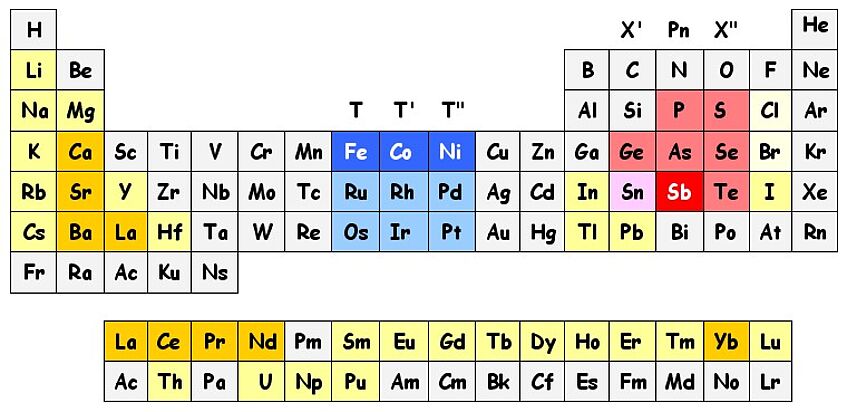
Distribution over the Periodic Chart of the various atom constituents forming skutterudite compounds.
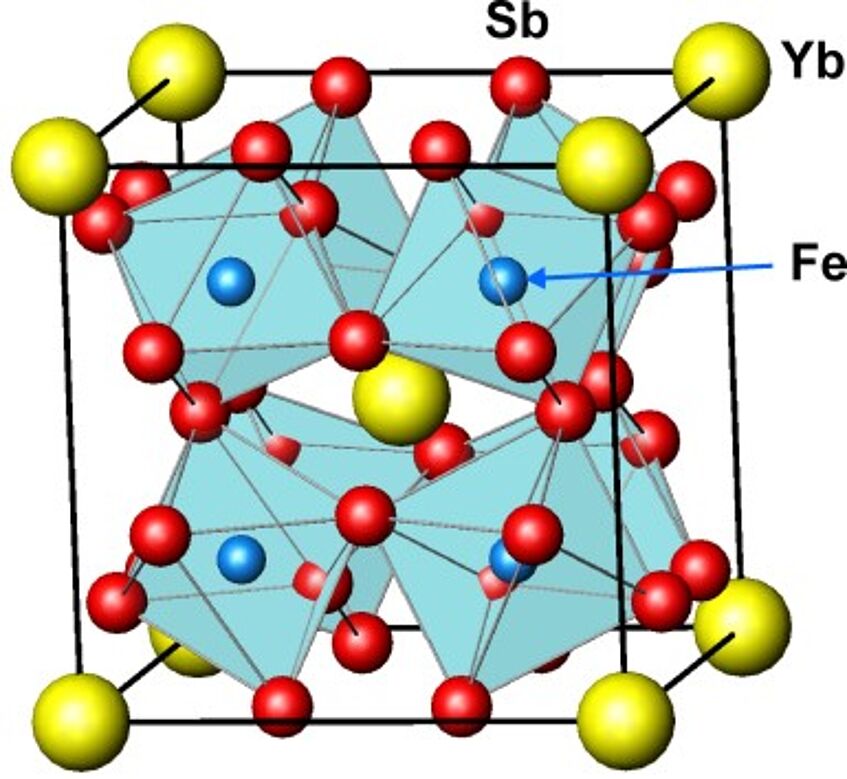
YbFe4Sb12 (LaFe4P12 – type)
space group Im-3
red: X in 24g (0, 0.1581, 0.3356)
blue: T in 8c (1/4, 1/4, 1/4)
yellow: EP in voids 2a (0,0,0)
Besides In-filled grades, triple or multiple filled Co-based solutions presently reveal the best n-type bulk materials with Sr, Ba, Yb or other light RE as filler atom species with zT=1.4 to 1.7 [1,2]. In-situ precipitates of Yb2O3 from excess Yb can yield zT=1.6 [2a] and is ZT=1.8 at 823 K for a high energy ball milled alloy Sr0.08Ba0.043Yb0.054Co4Sb12 +9.1 wt.% In0.4Co4Sb12 [2b]. For p-type bulks it proved necessary to shift the Fermi level to the low energy side of the band gap. This is generally achieved by substitution of Co by Fe. The increasing Fe-content concomitantly boosts the guest atom filling level, which in dependence of the electronic state of the guest atoms defines the proper range of substitution. The p-type skutterudites with the hitherto highest zT~1.2 are found among DDyFe4-xCoxSb12 (x~1; DD stands for didymium, a natural double filler consisting of 4.76% Pr and 95.24% Nd) [3,4,5]. Several studies showed that substitution of Sb-atoms with non-pnicogen atoms influences the electronic structure and due to enhanced scattering of phonons on electrons and impurities reduces the lattice thermal conductivity, leading to enhanced zT values e.g. zT = 1.3 for DD0.59Fe2.7Co1.3Sb11.8Sn0.2.
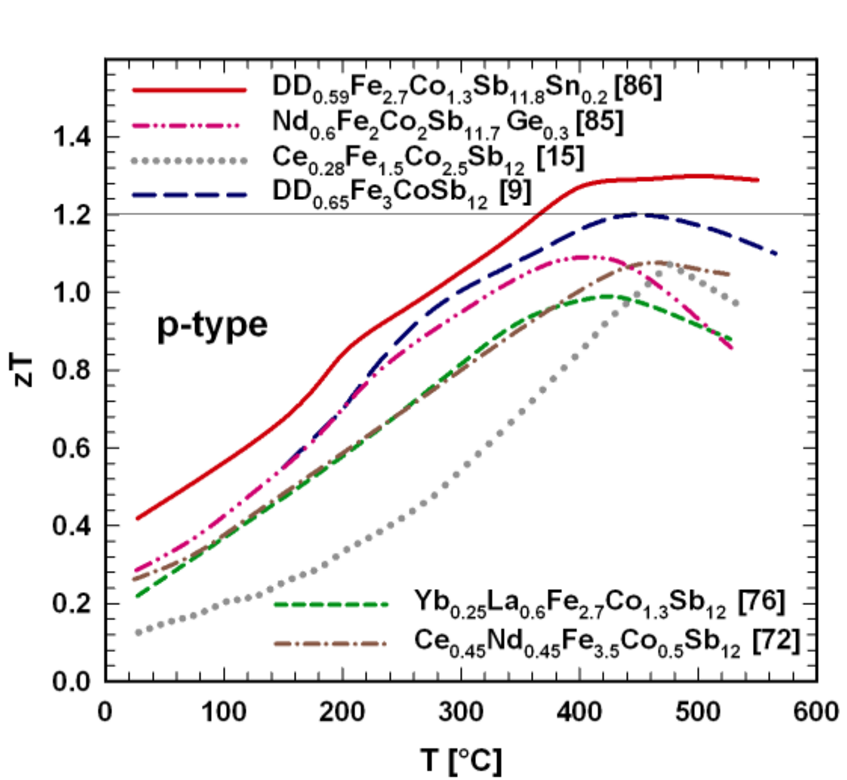
Figure 1 left) p-type skutterudites reaching a temperature dependent figure of merit, zT>1.0.
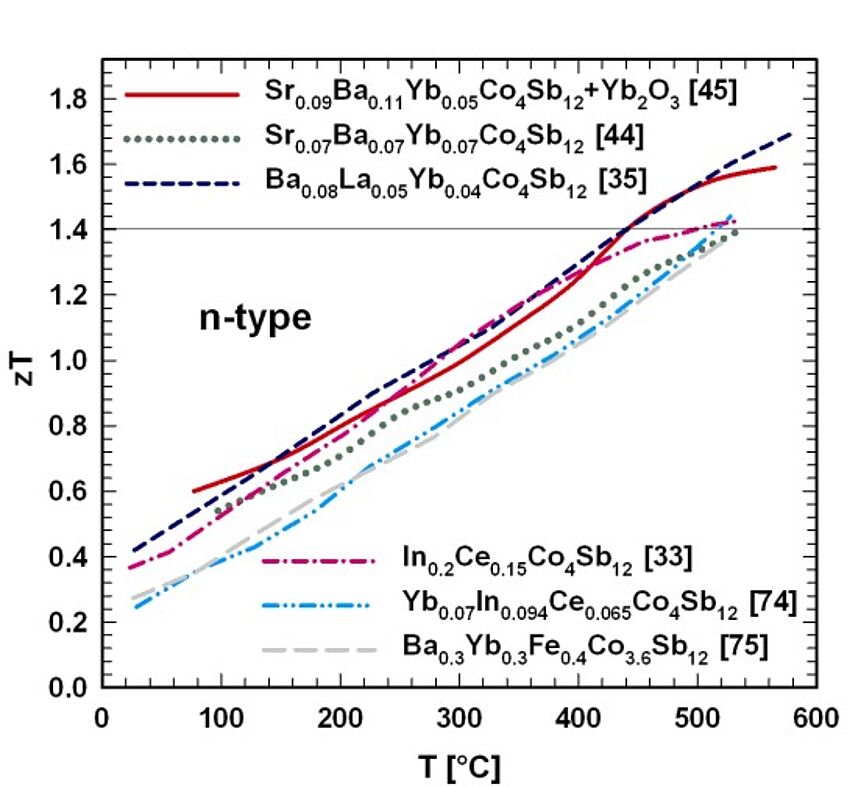
Figure 1 right) n-type skutterudites reaching a temperature dependent figure of merit, zT>1.4.

Figure 2) Temperature dependent figure of merit, zT, of filled skutterudites before and after severe plastic deformation.
A further increase of the thermoelectric efficiency was obtained from nanostructuring by applying severe plastic deformation processes (for instance HPT=high pressure torsion) as a tool to further reduce the crystallite size, to increase lattice defects, dislocation density etc. and thereby to increase the scattering of the heat-carrying phonons and approaching zT=1.9 (n-type) or zT=1.4 (p-type); see Fig. 2 (Ref. [6] and references therein).
Both ZT-values reached are currently world's best. Recently we have shown that a direct route via cold compacting and direct HPT treatment can produce p-type material with ZT~1.2 as a cheap processing route avoiding any hotpress step [9].
Material’s response to thermal and mechanical stresses generated by in-service conditions of a thermoelectric module demands a detailed knowledge of mechanical properties such as hardness, elastic moduli and thermal expansion (for details see refs. [7,8] and refs. herein), just to name our most important contributions. All these properties are strongly dependent on temperature, composition, porosity and grain size. Long term stability was investigated and discussed in refs [10,11]
Our cooperation with Treibacher Ind. AG in the CDL has lead to a bulk production (>50 kg charges) of high ZT p- and n-type powders. Treibacher Ind. AG is currently the only company in the world that can supply high ZT-powders at such a large quantity.
[1] Rogl, G., et al., Journal of Physics: Condensed Matter, 2011. 23(27): p. 11 pp.
[2a] Rogl, G., et al., Acta Materialia, 2014. 63(0): p. 30.
[2b] Rogl, G., et al., Acta Materialia, 2015. 95: p. 201.
[3] Rogl, G., et al., Intermetallics, 2010. 18(12): p. 2435.
[4] Rogl, G., et al., Intermetallics, 2011. 19(4): p. 546.
[5] Rogl, G., et al., Solid State Phenomena, 2011. 170: p. 240.
[6] Rogl, G., et al., in Thermoelectric Nanomaterials, Koumoto, K., Mori, T., Editors. 2013, Springer Berlin Heidelberg. p. 193.
[7] Rogl, G., Rogl, P., Science of Advanced Materials, 2011. 3(4): p. 517.
[8] Rogl, G., et al., J. Appl. Phys., 2010. 107(4).
[9] Rogl G., A. Grytsiv, R. Anbalagan, J. Bursik, M. Kerber, E. Schafler, M. Zehetbauer, E. Bauer, P. Rogl,"High Pressure Torsion – A New Promising Route to Produce High ZT Thermoelectric Materials", Acta Mater. 159, 352-363 (2018).
[10] G. Rogl, A. Grytsiv, E. Bauer, P. Rogl,"Thermoelectric Sb-Based Skutterudites for Medium Temperatures", in Advanced Thermoelectrics: Materials, Contacts, Devices and Systems (eds. Z. Ren, Y. Lan, and Q. Zhang), CRC Press, Boca Raton, FL, USA, pp. 193–230 (2018)
[11] "Skutterudites, a Most Promising Group of Thermoelectric Materials", G. Rogl and P.Rogl, in Current Opinion in Green and Sustainable Chemistry, Issue: Novel Materials for Energy Production and Storage (Ed. S. Schorr) Vol. 4, 50-57 (2017)
-) Research on High ZT Half Heusler Alloys
The so-called "Half Heusler" (HH) compound TiNiSn, known as an n-type semiconductor since 1986 has hitherto displayed a high potential for exceptional efficiency in thermoelectric (TE) generators converting (waste) heat into electricity. Thermoelectric research has, therefore, focused mainly on improvement of ternary intermetallic compounds based on TiNiSn, which crystallize with the non-centrosymmetric cubic MgAgAs-type structure (space group). HH compounds are promising candidates for high temperature thermoelectric applications because they inherit a tuneable electronic structure, which can be modified through (i) doping/substitution on its three metal sublattices, (ii) engineering of a generally narrow band gap, and (iii) nanostructuring via ball-milling and precipitation of secondary system inherent phases as the most prominent among many other techniques. An overview on the thermoelectric properties of HH alloys, reaching up to 700°C a ZTmax~1.0 for p-type Ti{FexCo1-x}{SnySb1-y} and a ZTmax~1.2 for n-type {Ti1-u-vZruHfv}Ni{Sn1-wSbw} can be found from recent review article [12].
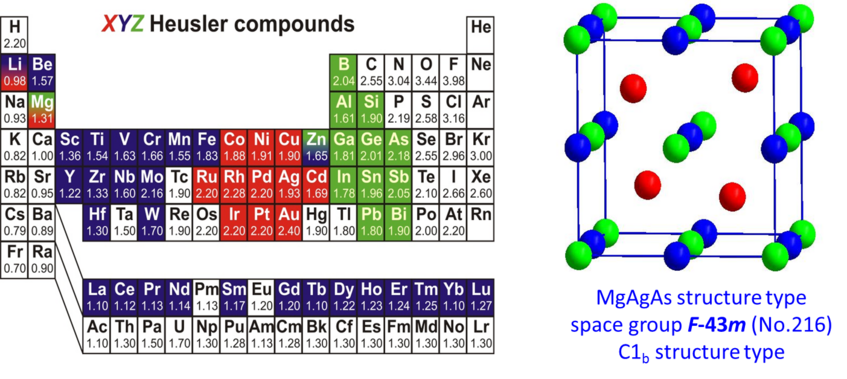
Periodic table of the elements. A large amount of of HH materials can be formed by combination of the different elements according to the color scheme (left). Crystal structure of a HH compound (right). See ref. [12]
Our research intended to provide (1) a liquidus surface for the entire phase diagrams Ti-Ni-Sn and Zr-Ni-Sn i.e. precise information on the solidification paths, and (2) phase relations in an isothermal sections at 950°C. As these systems are subsystems of a multi component thermoelectric alloy system, for which a thermodynamic (pre-) calculation can save extensive experimental work, the research furthermore includes a thermodynamic assessment of the Ti-Ni-Sn and Zr-Ni-Sn ternary. CALPHAD-type modelling (in cooperation with J. Vrestal from Masaryk University, CEITEC, Brno, Czech Republic) is based on existing assessments for the binary boundary systems as well as relies on experimental thermodynamic data for the ternary compounds and will be backed by DFT energies of formation (in cooperation with V. Romaka from the Department of Materials Science and Engineering, Lviv Polytechnic National University Ukraine) wherever needed in the modelling /see Figs. 3 and 4) from refs. [13-17].
The binodal and spinodal curves in the isopleths TiNiSn-ZrNiSn and TiNiSn-HfNiSn were calculated and they not only show that a hot-pressing temperature of 1100°C in both isopleths is sufficiently high above the critical point in order to obtain single-phase material but in addition the calculations provide the outline of the miscibility gap within spinodal/binodal decomposition, which facilitates epitaxial nano-precipitation for enhanced phonon scattering in thermal conductivity. For Ti0.50Zr0.25Hf0.25NiSn0.98Sb0.02 including DA we obtained a ZT~1.2 with an extremely high thermoelectric efficiency of almost 12%. Besides these pleasing results, our Hf-free alloys reach values of ZT~1 at 823 K, which compare favorably with Hf-containing best alloys in the literature. For Ti0.5Zr0.5NiSn0.98Sb0.02, we reach the highest ZT of almost 1.2 with an thermoelectric efficiency h>11%. These excellent TE results prove that Hf-free and therefore cheap half-Heusler alloys can be promising materials for a large scale production route. For details see Ref. [13-17]. For Hf-containing mater. we could show ZT=1.5 [16].
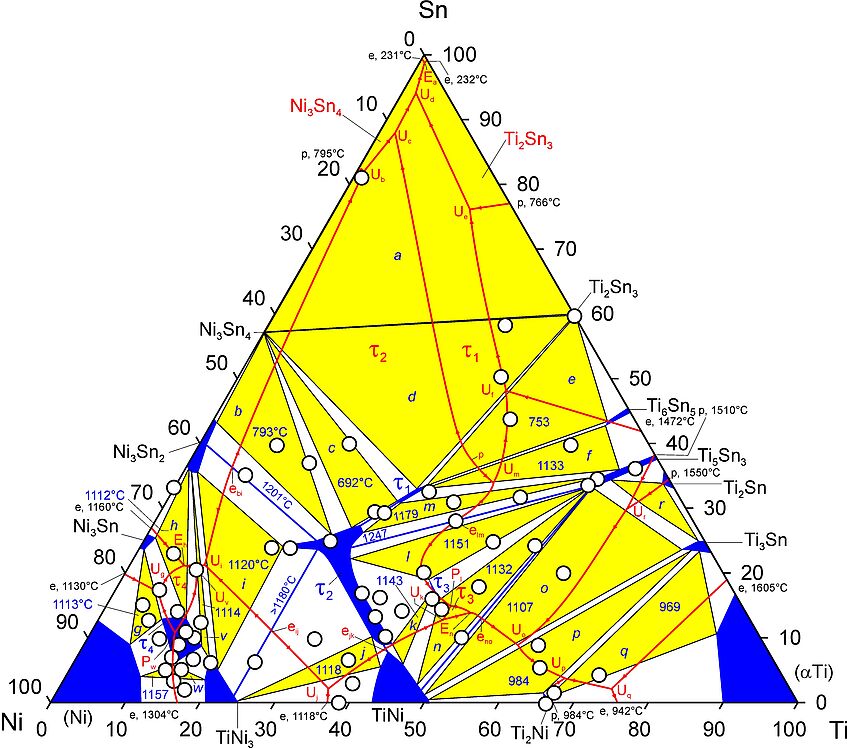
Fig. 3a. System Ti-Ni-Sn; sub-solidus surface with superimposed mono-variant liquidus lines.
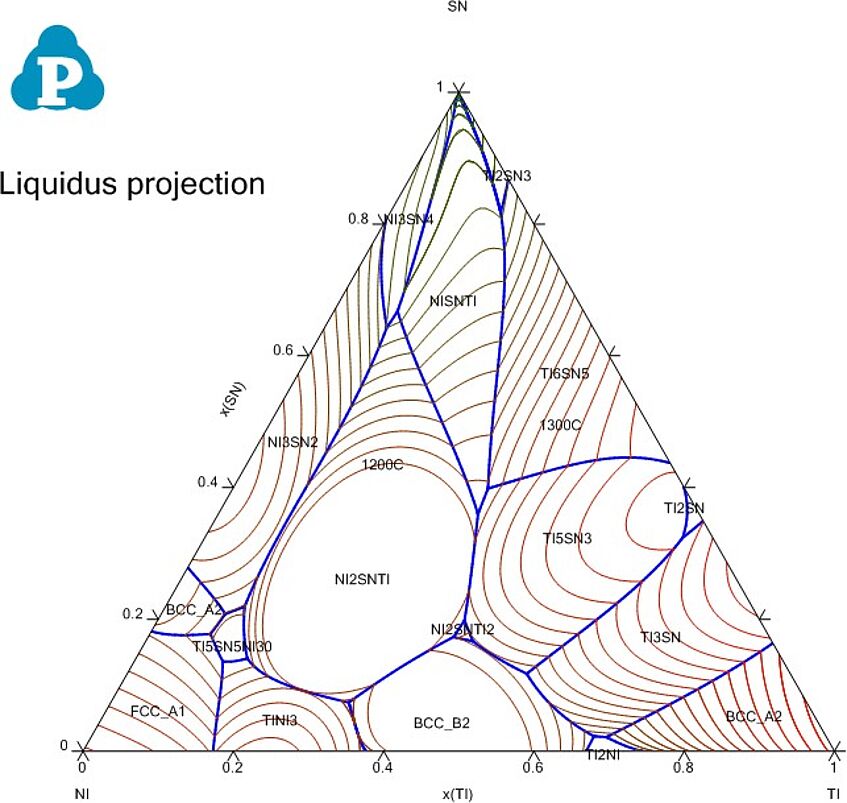
Fig. 3b: System Ti-Ni-Sn; calculated liquidus projection
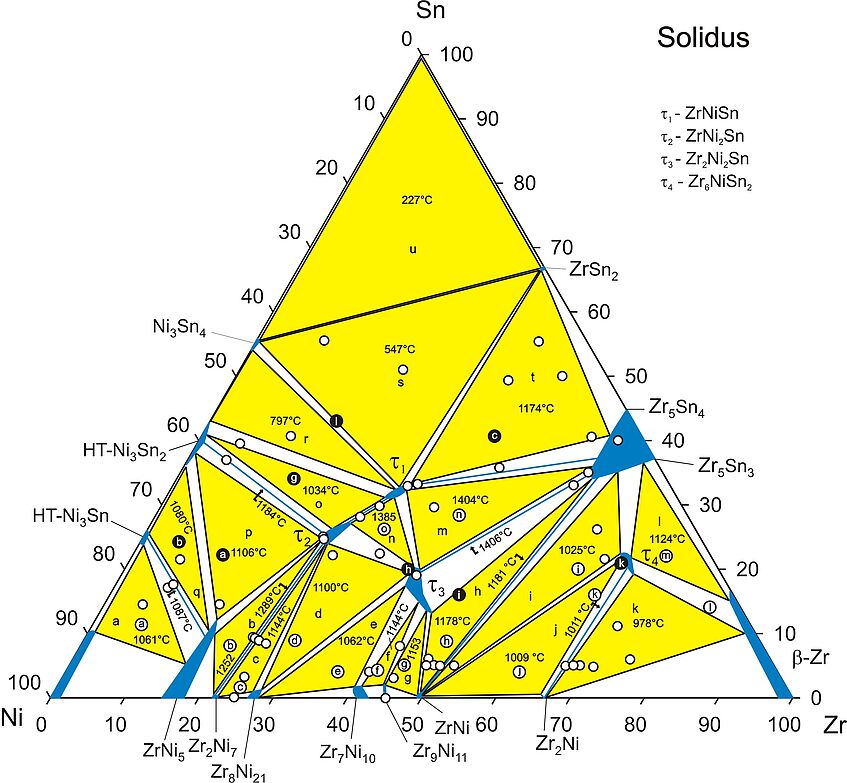
Fig. 3c. System Zr-Ni-Sn; sub-solidus surface.
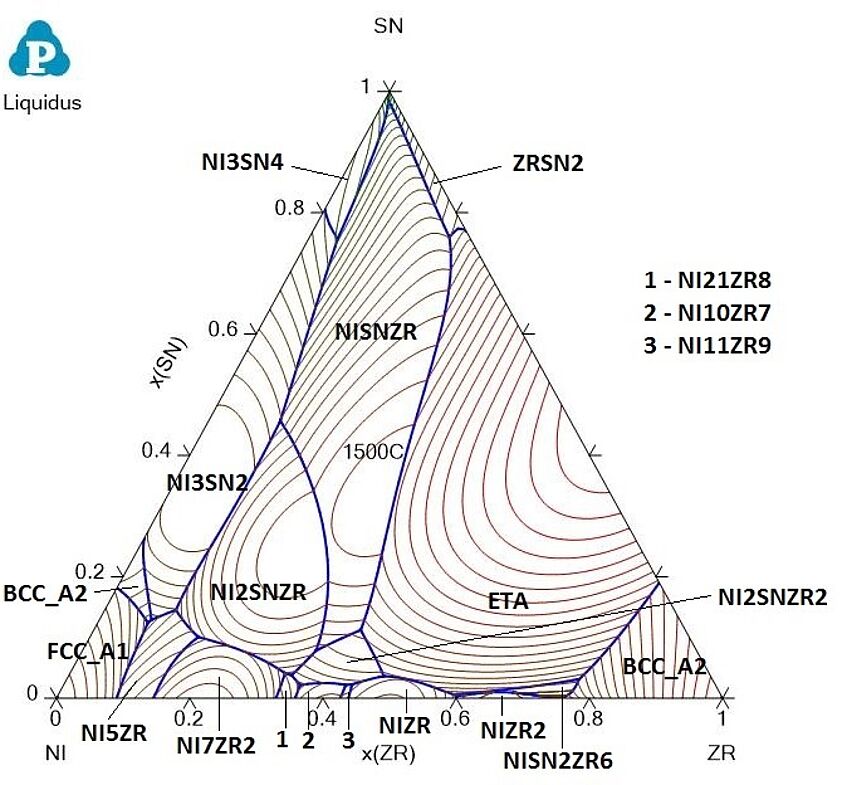
Fig. 3d: System Zr-Ni-Sn; calculated liquidus projection

Fig. 4a. Figure of merit, ZT, versus temperature, T, for various TiZrHfNiSn and TiZrNbVNiSnSb alloys.
For details see Ref. [16]
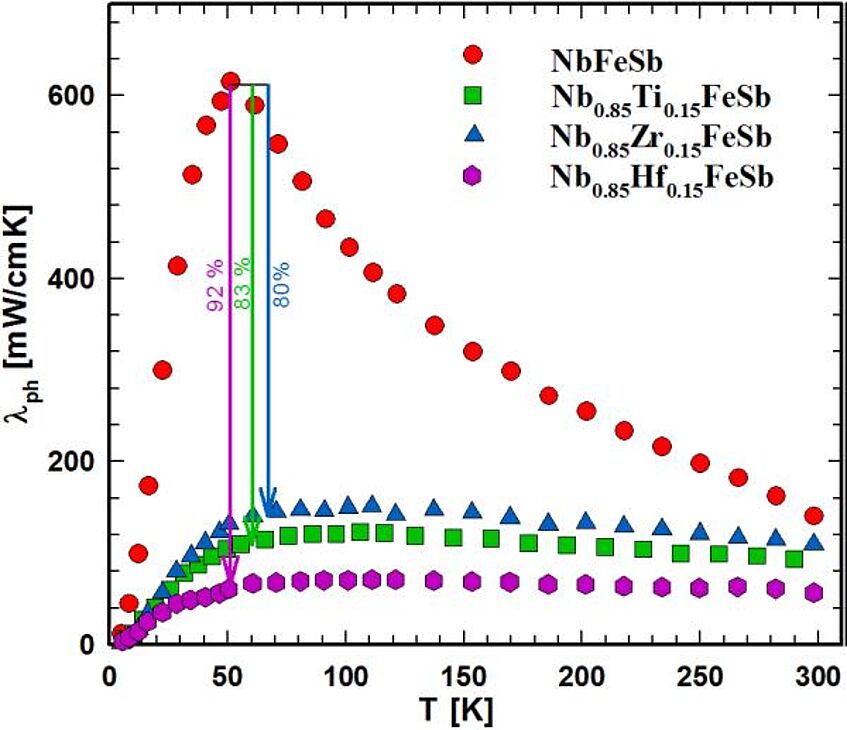
Fig. 4b. Temperature dependent corrected phonon thermal conductivity at low temperatures for M0.15Nb0.85FeSb (M=Nb, Ti, Zr, Hf). Ref.[17]
[12] G. Schierning, Ruben Chavez, R. Schmechel, B. Balke, G. Rogl, P. Rogl, Concepts for medium high to high temperature thermoelectric heat-to-electricity conversion: A review of selected materials and basic considerations of module design,
[13] M. Gürth, G. Rogl, V.V. Romaka, A. Grytsiv, E. Bauer, P. Rogl, Acta Mater., 104 (2016) 210-222.
[14] M.Gürth, G.Rogl, V.Romaka, A.Grytsiv, E.Bauer, P.Rogl, Acta Mater.104 (2016) 210
[15] P. Sauerschnig, A. Grytsiv, J. Vrestal, V.V. Romaka, B. Smetana, G. Giester, E. Bauer, P. Rogl,"On the Constitution and Thermodynamic Modelling of the System Zr-Ni-Sn", J. Alloys Compd., 742, 1058-1082 (2018).
[16] G. Rogl, P. Sauerschnig, Z. Rykavets, V.V. Romaka, P. Heinrich, B. Hinterleitner, A. Grytsiv, E. Bauer, P. Rogl, "(V,Nb)-doped Half Heusler alloys based on {Ti,Zr,Hf}NiSn with high ZT", Acta Mater. 131, 336-348 (2017)
[17] A. Tavassoli, F. Failamani, A. Grytsiv, G. Rogl, P. Heinrich, H. Müller, E. Bauer, M. Zehetbauer, P. Rogl,"On the Half-Heusler Compounds Nb1-x{Ti,Zr,Hf}xFeSb: Phase Relations, Thermoelectric Properties at Low and High Temperature, and Mechanical Properties", Acta Mater. 135, 263-276 (2017)
B) Refractory Superhard Materials & Corrosion Resistant - High Temperature Structural Materials
The search for superhard and/or incompressible materials has led to a renewed research interest in binary transition metal borides especially on those with the highest boron contents.
Investigations:
a. Determination of phase equilibria, compatibility, phase formation (LOM, SEM, X-ray Diffr.)
b. Crystallographic characterization of novel compounds via X-ray single crystal refinement, neutron and X-ray high and low temperature powder diffraction techniques.
c. Determination of strains and preferrred orientation in layer structures.
d. DFT calculations of phase stabilities and mechanical properties of boride phases (XQ. Chen, Chin. Acad. Sci., Shenyang, China)
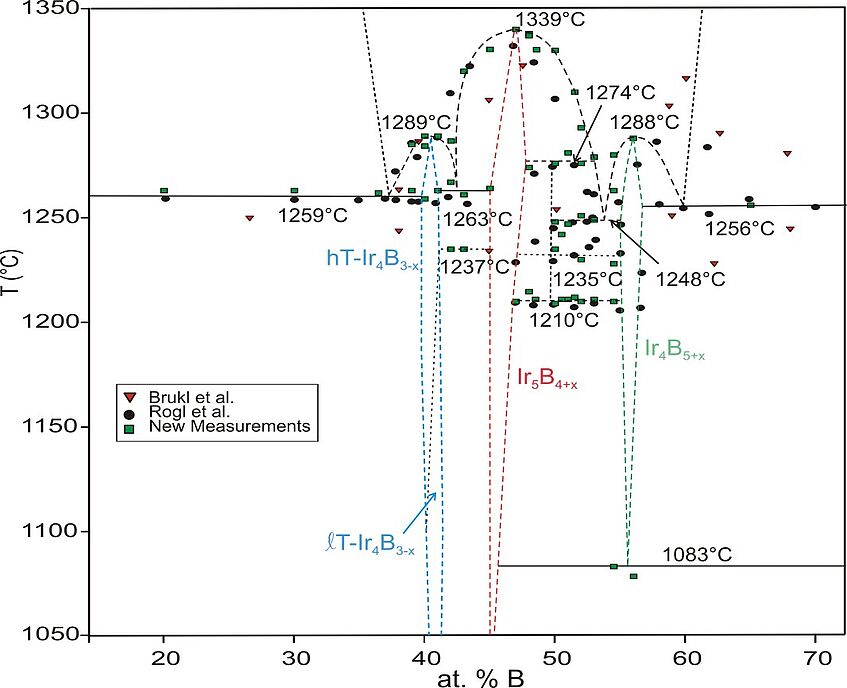
Phase diagram of Iridium - Boron [18]
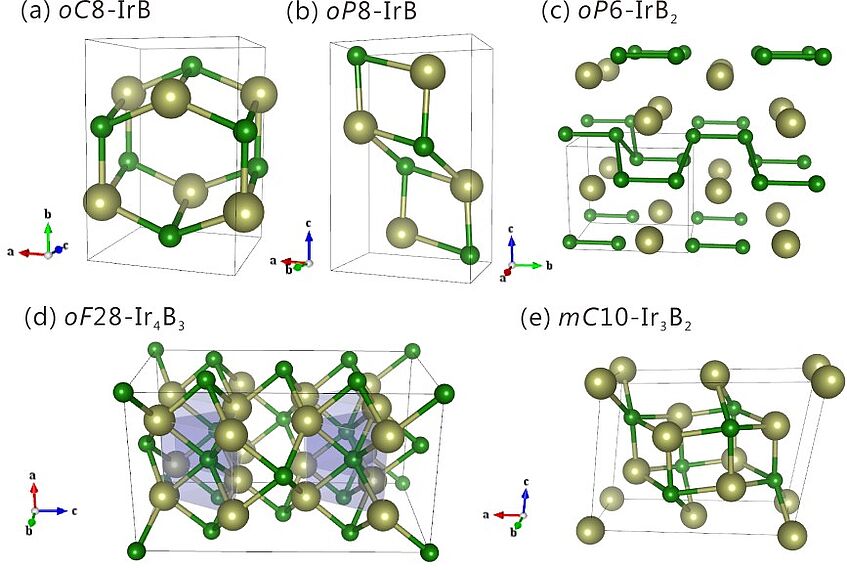
Crystal structures of DFT predicted Ir borides at ambient pressure. (a) oC8-IrB, (b) oP8-IrB, (c) oP6-IrB2, (d) oF28-Ir4B3 and (e) mC10-Ir3B2. The golden and green spheres represent Ir and B atoms
[18] I. Zeiringer, Xiyue Cheng, Xing-Qiu Chen, E. Bauer, G. Giester, R.F. Rogl, Science China Materials, 58(8), 649-668 (2015)
C) Strong Electron Correlations in cerium, europium, ytterbium compounds
Within an Austrian cooperation between the Institute of Physical Chemistry, University of Vienna (P. Rogl) and the Institute of Solid State Physics, Technical University of Vienna (E. Bauer) (FWF-projects 13670, 15066) assisted by an international research cooperation (INTAS project 234: “Search for Novel Cerium and Uranium Compounds with Special Magnetic and Superconducting Properties”, Austria(P.Rog)l, France(H.Noel), Russia(Y.Seropegin), Ukraine(O.Bodak)) a new compound has been characterized, CePt3Si (CePt3B type), as the first heavy fermion superconductor without a center of symmetry [“Heavy Fermion Superconductivity and Magnetic Order in Non-centrosymmetric CePt3Si”, E. Bauer, G. Hilscher, H. Michor, C. Paul, E.W. Scheidt, A. Gribanov, Yu. Seropegin, H. Noel, M. Sigrist and P. Rogl; Phys. Rev. Lett., 92(2), 027003,1-4 (2004)]. CePt3Si has attracted widespread attention due to distinct constrictions regarding the superconducting order parameter, which possibly gives rise to a novel superconducting state.
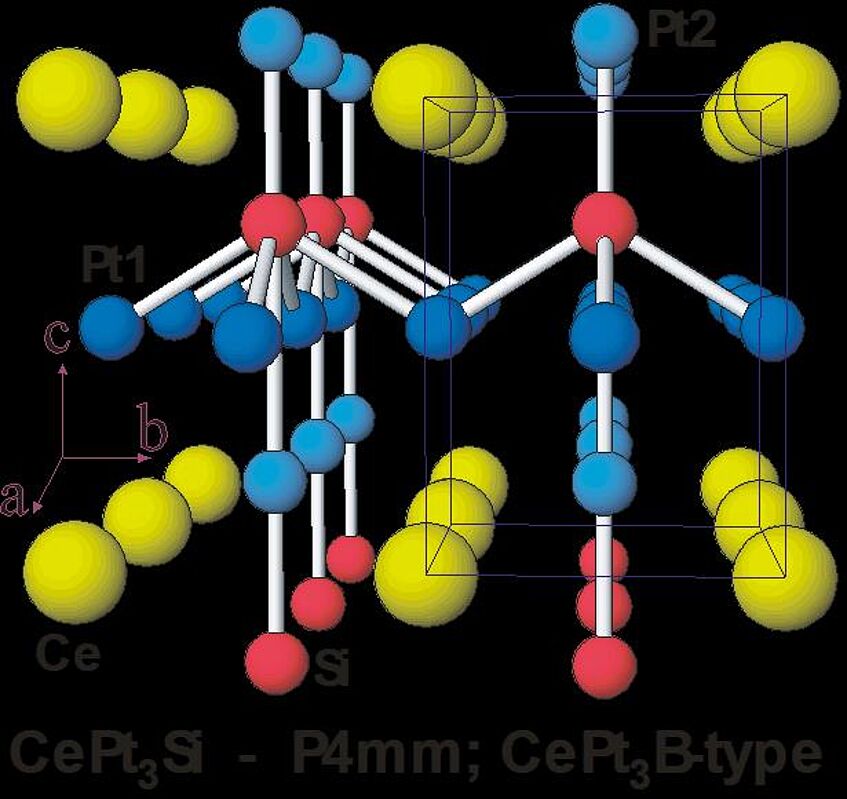
Left: Crystal structure of CePt3Si: The bonds indicate the pyramidal coordination [Pt5]Si around the Si atom. Origin shifted by (0.5,0.5,0.8532) for convenient comparison with parent AuCu3 structure
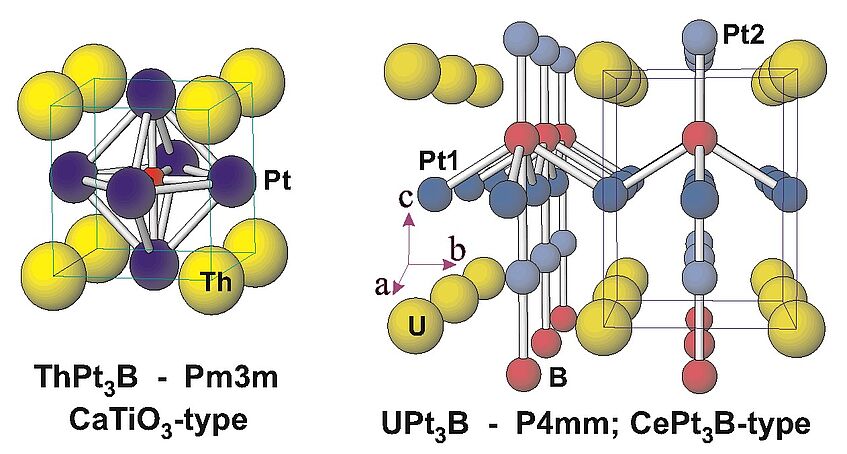
Middle: Superconductor ThPt3B with Perowskite type. Right: Spin fluctuator UPt3B with CePt3B-type
However, not only the superconducting properties but also normal state physics of ternary CePt3Si show a number of exceptional features. Hence, a thorough understanding of the interplay of superconductivity, driven by magnetic fluctuations, with Kondo type interaction and crystal electric field (CEF) splitting is still incomplete. To gain more insight into general physical properties of such compounds, research programmes were designed to generally investigate isomorphous rare earth platinum silicides adopting the CePt3B structure type as well as superconductors with non-centrosymmetric crystal lattices in general. In the course of these studies we recently were able to discover further heavy fermion compounds and superconductors.
General activities and interest covers the following topics:
(1) Preparation, constitution, crystal chemistry and physical properties of superconductors
(2) Valence instabilities-IC, Kondo-behavior
(3) Interactions of magnetism-superconductivity
(4) Heavy fermion behavior, Non-Fermi Liquids
[19] “Superconductivity in Non-centrosymmetric Materials”, F. Kneidinger, E. Bauer, I. Zeiringer, P. Rogl, C. Blaas-Schenner, D. Reith, R. Podloucky, Physica C: Superconductivity and its Applications, 514, 388-398 (2015)
[20] "Mechanical Properties of Non-Centrosymmetric CePt3Si and CePt3B", G. Rogl, D. Legut, P. Rogl, P. Müller, H. Müller, E. Bauer, S. Puchegger, G. Polt, M. Zehetbauer, J. Phys.: Condens. Matter, 29, 185402, 1-9 (2017)
International Research Cooperations (resulting in joint publications)
- • Lab. de Chimie Solide, CNRS, Université Bordeaux I, Talence, France (J. Etourneau, B. Chevalier)
- • URA-CNRS 254, Université de Rennes, Rennes, France (H. Noël) and INSA (J. Bauer, J. Debuigne)
- • SINQ, Labor f. Neutronenstreuung ETH-Zürich, PSI Wuerenlingen, Schweiz (P. Fischer, V. Pomjakishin)
- • LLB-Saclay, Labor f. Neutronenstreuung, Saclay, France (F. Bouree, G. Andre, A. Goukassov)
- • Institute of Inorganic Chemistry, State University Lviv, Ukraine (O. Bodak)
- • Dep. Mater. Science & Engineering, Lviv Polytechnic Natl. Univ., Lviv, Ukraine (L. Romaka)
- • Masaryk University, CEITEC, Brno, Czech Republic (P. Broz, J. Vrestal, J. Houserova)
- • Czeck Acad. Sci., Institute of Physics of Materials (J. Bursik)
- • Physics Department, University of California, Santa Cruz, USA (F. Bridges)
- • Lab. de Chimie Metallurgie des Terres Rares, Equipe de Recherche 209, Thias, France (C. Godart)
- • Max Planck Institut, Institut f. Werkstoffwissenschaften Stuttgart, BRD (F. Aldinger)
- • Istituto di Chimica Generale, Universita di Genova, Italy (A. Saccone)
- • Institute for Low Temperature & Structural Research, Acad. Sciences, Wroclaw, Poland (D. Kaczorowski)
- • Inst. for Problems of Materials, Ukr. Acad. Sciences, Kiew, Ukraine (T. Velikanova)
- • Demokritos Research Center, Athens, Greece (N. Niarchos)
- • Insitut für Festkörperphysik (IFP), Technische Universit Dresden (M. Loewenhaupt, M. Doerr)
- • Insitute Laue Langevin, ILL, Grenoble, France, (M. Koza)
- • Forschungszentrum Jülich, Germany, (W. Schmidt, R. Hermann))
- • European Synchrotron Radiation Facility, Grenoble, France, (C. Detlefs)
- • Charles University Prague, Czech Republic, (V. Sechovsky)
- • National High Magnetic Field Laboratory, Tallahassee, USA (J. Brooks)
- • Hahn Meitner Institut, Berlin, Germany, (K. Prokes, J. U. Hoffmann, S. Raasch)
- • Northeastern University, Inst. Nonferrous Materials, Shenyang, P.R. China (X.Y. Ding)
- • Chinese Acad. Sci. Shenyang National Laboratory for Materials Science, Shenyang, China (X.Q. Chen)
- • NIMS, Tsukuba, Japan (T. Mori)
- • Univ. Hiroshima (T. Takabatake)
- • Inst. Exp. Physics, Slovak Acad. Sciences, Kosice, Slovakia (M. Mihalik)
- • Inorgan Chemistry, Lomonossov Univ., Moscow, Russia (A. Gribanov)
- • Univ of California, San Diego, USA (B. Maple)
- • Univ. Lexington, Kansas, USA (L. DeLong)
- • Centro Atomico, Bariloche, Argentina (J. Sereni)
- • Technical Res. Lab. Toyo Kohan Co. Ltd., Kudamatsu, Japan (K.I. Takagi)
- • Inst. of Materials in Lorena, Univ. Sao Paolo, Brasil (C. Nunes, G. Coelho)
- • Indian Institute of Science, Bangalore, India (R.C. Malik)
- • Institute for Materials Research, Tohoku University, Sendai, Japan (K. Yubuta)
- • EMPA, Solid State Chemistry & Catalysis, Dübendorf, Switzerland (A. Weidenkaff)
- • Institut für Angewandte Physik, Universität Tübingen, Germany (O. Eibl)
- • Dept. Quimica, ITN / CFMCUL, Sacavem, Portugal (A. Goncalves)
- • University of Duisburg-Essen, Duisburg, Germany (G. Schierning)
